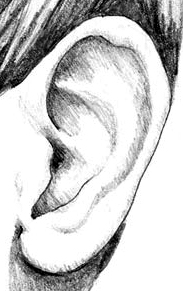CATALYTIC REACTIONS?
If you have a photo or other graphic that reflects an aspect of life (including laboratory life) or a quotation that scientists might appreciate that would be fit to print in the space to the right, why not
send it to us via e-mail:
<catalyst@nih.gov>; fax: 402-4303; or mail: Building 2, Room 2E26.
Also, we
welcome "letters to the editor" for publication and your reactions
to anything on the Catalyst pages.
In Future Issues...
Framingham's New Home
Copyright Issues
Sequencing the Microbiome
 |
Kids' Catalyst: Psst . . .
Want to hear something?Hey! Hey!! Please put those headphones down for just a minute and listen. Thank you. What? You can't hear me so well because the music was loud and your ears are ringing? Just give it a few minutes—and read a little bit about the ear in the meantime.
Our ears are complex, sensitive, and capable (in theory, if not in practice) of detecting sound signals that are very low or very high in both tone and intensity.
The terms "tone," "frequency," and even "pitch" are sometimes used interchangeably. Someone like your little sister most likely has a high voice—a high-frequency voice. Your dad's is usually much, much lower. If you ask someone to play 440 hertz (or Hz, the unit frequencies are measured in), they'll stroll over to a piano and hit the A above middle C—the audio frequency reference. Your sister's voice is much higher than that.
"Intensity" is how loud something is, measured in decibels. The intensity of parents quietly plotting where to hide your present is about 20 decibels (or dB, the unit used to measure loudness). That music you were just listening to is 80–100 dB—or more. No wonder your ears hurt.
As a side note, how much louder is 80 dB than 20 dB? You get to look that one up yourself, but a hint for you is that it's probably not what you think. Then you can also look up dB "sound intensity levels" versus "dB sound power levels"–and teach me about it!
The normal tone range of the human ear is 20–20,000 Hz. Actually, we're exposed to more than 20,000 Hz all of the time, we just don't hear it (so that's okay). Not so with decibels: If you're listening to something louder than 85 dB for a long time, it can cause gradual hearing loss, and more than 110 dB for more than a minute may bring permanent hearing loss.
So if you want to keep on enjoying the ability to hear soft conversations about where gifts for you are hidden, you might want to turn the music down. It's good for your snooping future. I know it's not so easy. After all, headphones are great because you hear what no one else hears and no one is asking you to turn the noise down in the middle of the night. But though others may not be bothered by your loud music, you will be when you just can't quite make out what people are whispering about.
For more information about the ear, how to protect it, and much more, go to this website.
—Jennifer White
|
PUBLISHER EDITORS Henry
Metzger
|
MANAGING
EDITOR WRITER-
EDITOR COPY
EDITOR |
EDITORIAL
ADVISORY BOARD
|